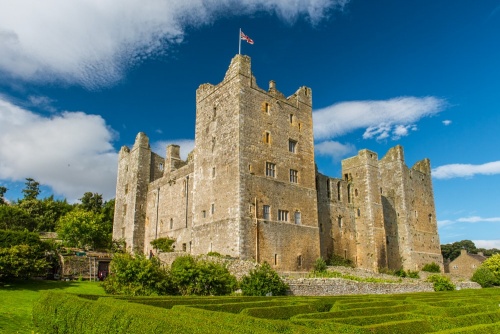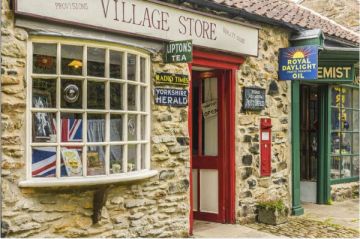
Bolton Castle is a stark and imposing medieval fortress at the entrance to Wensleydale, begun by Richard le Scrope in 1378. Scrope was Lord Treasurer and Lord Chancellor to Richard II, and one of the most powerful men in late 14th-century England. His new castle was intended to be a symbol of that power, and one look at the sturdy stone walls will tell you he succeeded.
Even today, driving along the minor road from Redmire, the outline of Bolton Castle seems to dominate the surrounding countryside like few other castles I've had the pleasure of visiting. To Scrope's contemporaries it must have been an intimidating sight indeed. Scrope may have presumed upon his royal position, for the license to crenellate was obtained in 1379, when the castle was almost complete.
Scrope spared little expense building his new stronghold; from 1379 until the structure was completed around 1399 he spent some 18,000 marks on Bolton Castle. He had enough spare change left over to buy the kingship of the Isle of Man for his son William, at a cost of 10,000 marks. Poor William was executed without a trial the following year after the fall from power of his lord, Richard II.
Scrope fought in every major battle between 1346 and 1384. Historians suggest that he was the 'truly perfect, gentle knight' described by Geoffrey Chaucer in his Canterbury Tales. Certainly, Scrope's military history seems to match that of Chaucer's knight. Chaucer was acquainted with Lord Scrope and testified on his behalf in a famous court case over who should have the right to bear the heraldic symbol of 'Arms azure a Ben d'Or'.
When Sir Richard died in 1403 he gave 13s 4d to every resident of Richmondshire and 2s to every prisoner in York gaol.

The Architect
Bolton Castle is unusual in that we actually know the name of the man responsible for building it, not just the lord who paid for the building. In this case, the architect was John Lewyn, a master mason who was one of the most prolific and important architects in medieval England. Lewyn first appears in the historical record in 1353 as a young mason in royal employ at Westminster and, later, at Windsor Castle.
From 1366 he was used by the Bishop of Durham to build the great tower of Durham Castle and later the same year he remodelled the apartments at Bamburgh Castle for the Crown. We know that he worked on other royal buildings along the Scottish border, such as Roxburgh Castle and Carlisle Castle.
Powerful noblemen were keen to hire the royal mason for their own strongholds, and he may have been hired by the Neville family to work on Raby Castle and Sherriff Hutton Castle. He also worked on Dunstanburgh Castle for John of Gaunt, but his best-surviving work is the great tower of Warkworth Castle.
At Bolton Castle, Lewyn designed a rectangular structure with sturdy square four-storey towers at each corner, enclosing an inner courtyard. The towers were joined by three-storey ranges, with turrets in the centre of both the north and south ranges.
The main entrance is through a gatehouse on the east side. Historians have argued over whether the castle was originally surrounded by a moat, but it seems most likely that it was not.

Bolton is an almost perfect example of a rectangular castle; unlike many contemporary fortresses, the living and working quarters were built into the ranges along each wall, rather than added as lean-to structures against a curtain wall.
The corner towers are not truly flanking towers; they do not project very far beyond the range walls, and thus would not have offered a very good line of fire for archers aiming along the wall.
But there were other defences; if an attacker managed to penetrate the long passage through the gatehouse, with its iron portcullis, they would find themselves in a death-trap, for the inner court is overlooked by four ranges, with narrow arrow slits in the walls for archers to pour down a rain of fire on the intruder.
Only five doors join the ranges to the courtyard, and each doorway is defended with its own portcullis. Four of the doors are also protected by machicolations (slots for hurling missiles or pouring something unpleasant) overhanging each door.
The ground floor of each range has barrel-vaulted chambers for storage, stables, and all the necessary workshops for a thriving castle community. First and second floor chambers were for living quarters.
By the standards of 14th-century England, the living quarters at Bolton Castle are large and comfortable, and what is more, they provided a remarkable amount of private living areas in an age where concepts of privacy were foreign to most people.
One oddity at Bolton Castle is the spiral stairs. Most stairs of this period spiral upwards in a clockwise direction to allow defenders more space to swing a sword (assuming most would be right-handed swordsmen). At Bolton Castle, the principle stairs spiral the wrong way; counter-clockwise. Each stair has a pair of 'trip-steps' cut to an unequal size to trip up an attacker creeping up in the dark.

Mary, Queen of Scots
Bolton Castle's most famous moment in history came in 1568, when Mary, Queen of Scots was imprisoned here after her escape from Scotland. The chambers in the south-west tower where she is thought to have stayed have been arranged to reflect what they would have looked like during her imprisonment.
The Scottish queen's imprisonment was not unpleasant; she had the best chambers in the castle and was attended by a household of 51 people including, two English sisters, three laundresses, a surgeon, an apothecary, a reader, four grooms, and most curiously, 'two others'.
Only 36 of her retinue found quarters in the castle itself; the remainder had to find lodging nearby. The castle did not have suitable furnishings for a queen, so furniture and tapestries had to be borrowed from nearby houses. Queen Elizabeth I even loaned her cousin some pewter tableware and a kettle.
The queen was allowed a certain freedom of movement and spent long hours hunting in the surrounding area. She was also allowed to meet local Catholics, something that Lord Scrope was heavily reprimanded for.
Mary arrived at Bolton Castle in July 1568 and left in January 1569 for Tutbury Castle, where she was to spend much of the next 18 years in captivity.

A Haunted Bed
The four-poster bed in Mary's room is not original to the castle. It was given to Lord Bolton because its previous owners considered the bed to be haunted. According to their tale, no one had been able to spend an entire night in the bed without suffering hallucinations and dreadful nightmares. They had the bed exorcised twice but the hauntings continued, so they were very keen to have Lord Bolton take it away.
Above the Mary, Queen of Scots Bedchamber is the chamber originally used by Lord Scrope as his own bedchamber.
The heart of the castle chambers is the Great Chamber, which overlooked the courtyard. Mary, Queen of Scots hung her cloth of Estate here, and a visitor describes her sitting by the window doing her needlework while Lord Scrope and Sir Francis Knollys played chess.
The end for Bolton Castle came in the Civil War, when John Scrope, only a teenager at the time, held the castle for the Royalist cause. Parliament besieged the castle for an entire year, and in November 1645 Scrope was forced to surrender after the garrison had been reduced to eating their own horses to survive starvation.
Parliament intended to slight the castle to make it unusable in future, but the south-west tower and the west range survived almost completely intact and habitable.
Bolton Castle is still owned by a direct descendant of the 14th-century Lord Scrope who built this impressive fortress. Below the castle walls is a recreation of a medieval garden. This has been extended to include a maze, rose garden, herb garden, vineyards, and a bowling green.
There are regular special events and activities throughout the year, and Bolton is also a popular venue for filming and for weddings. On our last visit, there was a hawking display going on. Immediately opposite the castle entrance is the beautiful medieval parish church, which is usually open to visitors.
Visiting Bolton Castle
It was a dismal, drab day when I visited Bolton Castle. Not too surprisingly, there were few other visitors, but I was very impressed with what I saw. The living quarters have been set with 'tableau' illustrating periods in the castle's history, including the Civil War siege and, of course, Mary, Queen of Scots imprisonment.
I'm not always a big fan of displays like this, but I must admit I was pleasantly surprised; it really helped bring the castle to life and make dry history much more interesting. I began to feel for Queen Mary, for a start, and I'm not always terribly sympathetic towards her! I enjoyed Bolton Castle enormously.
Update
As you can see from the photos accompanying this article our family returned to Bolton Castle, this time on a lovely sunny day in late August. What a magnificent view the castle is as you drive up Wensleydale and see it rising above the valley as you draw near! The views from the castle itself are stunning, and the wealth of information on the different parts of the castle open to visitors is simply outstanding.
Please take the time to wander around Castle Bolton village and explore St Oswald's 14th-century church opposite the castle.
About Bolton Castle
Address: Castle Bolton,
Yorkshire Dales,
Yorkshire,
England, DL8 4ET
Attraction Type: Castle
Location: 5 miles west of Leyburn, off the A684. Open from Spring through November. Admission charge.
Website: Bolton Castle
Email: info@boltoncastle.co.uk
Historic Houses Association
Location
map
OS: SE035 919
Photo Credit: David Ross and Britain Express
HERITAGE
 We've 'tagged' this attraction information to help you find related historic attractions and learn more about major time periods mentioned.
We've 'tagged' this attraction information to help you find related historic attractions and learn more about major time periods mentioned.
Historic Time Periods:
Find other attractions tagged with:
14th century (Time Period) - castle (Architecture) - Civil War (Architecture) - Mary, Queen of Scots (Person) - Medieval (Time Period) - moat (Historical Reference) - Queen Mary (Person) - Richard II (Person) - Royalist (Person) -
NEARBY HISTORIC ATTRACTIONS
Heritage Rated from 1- 5 (low to exceptional) on historic interest
Castle Bolton, St Oswald's Church - 0.1 miles (Historic Church) ![]()
Aysgarth, St Andrew's Church - 2.5 miles (Historic Church) ![]()
Wensley, Holy Trinity Church - 3.8 miles (Historic Church) ![]()
Swaledale Museum - 4.6 miles (Museum) ![]()
Coverham, Holy Trinity Church - 5.2 miles (Historic Church) ![]()
Askrigg, St Oswald's Church - 5.5 miles (Historic Church) ![]()
Coverham Abbey - 5.6 miles (Abbey) ![]()
Mill Gill Force Waterfall - 6 miles (Countryside) ![]()












